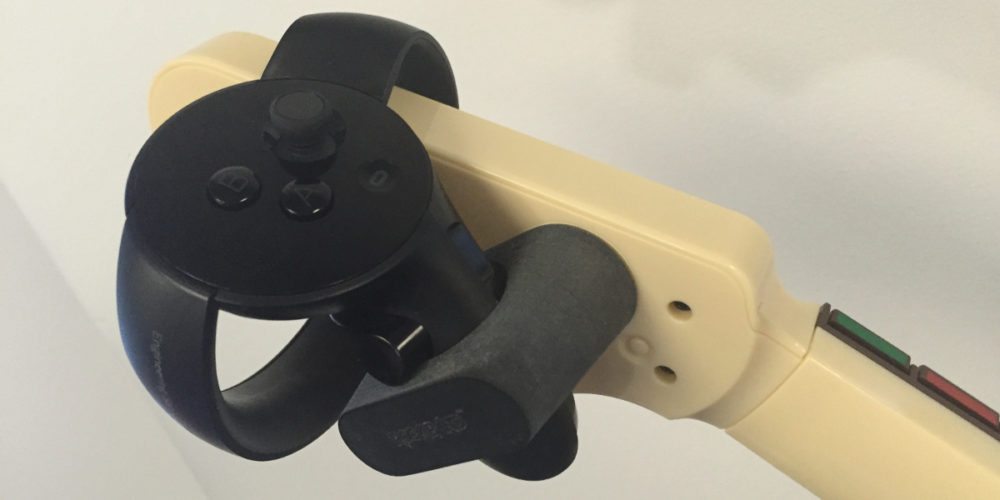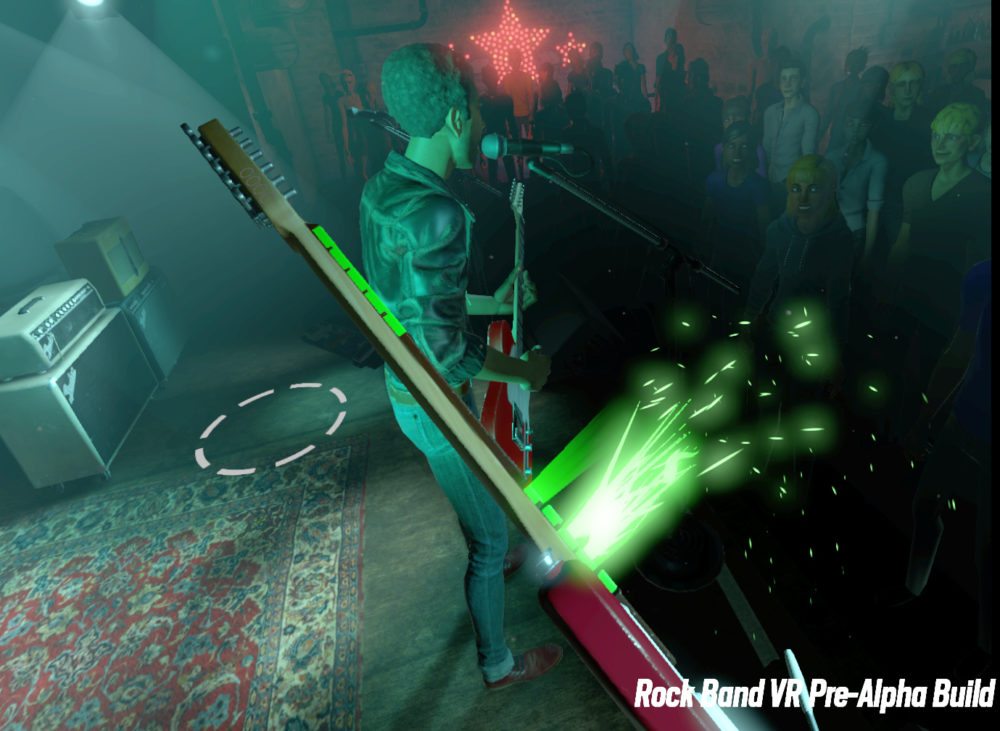
The night before PAX West, I was lucky enough to meet with Harmonix and return to my musical roots in Rock Band VR. I’m really excited about how they’re moving the game into virtual reality, and the new game mechanics felt more natural than anything I’ve played in the genre before!
Rock Band VR (RBVR) is an offshoot of the main franchise. (Purists need not fret: Rock Band Rivals was still showing at PAX as its own product.) The first difference I noticed was visible in the real world: an Oculus Touch controller was attached to the neck of the Rock Band guitar. This wasn’t a kludge of any kind; there was a connector that firmly and precisely mated the Touch to the headstock of the guitar, such that the Touch’s loop sat around the guitar’s neck. Incredibly, Harmonix told me that these connectors will be included with the Oculus Touch! Even better, while there is an updated, lower-latency guitar available for RBVR, if you already have a guitar from RB3 or RB4, it will work with the connector and Rock Band VR.

Following a short demo, I donned the Oculus Rift and got ready to rock. I was highly impressed by the positioning of the guitar in the virtual world. The location of the neck and fret buttons appeared exactly where I expected them to be. Sliding my hands along from fret to fret made this even easier; I didn’t grab the wrong frets any more than I do in regular Rock Band. I was even able to slide down to the bottom of the neck and find the frets without much fumbling.
Exploring the stage space brought a depth to the experience I hadn’t expected. It’s awesome. The crowd is there, anticipating your performance. There are a few positions on the stage with lit circles. Looking at them and holding the whammy bar teleports you to that location. So you can be stage left or right, or hang back with the drummer if that’s your style.
Speaking of the drummer, it was time to jam. Having previously selected “Gold on the Ceiling,” I heard him say, “Just gimme a sign.” All I had to do was turn my head, look at the drummer for a moment, and he launched into his beat. That’s a nice touch.
When it comes to gameplay, Rock Band VR differs dramatically from traditional Rock Band. There is no note highway. While the team did a lot of experimentation in this area, it just never felt right to bring that metaphor into virtual reality. After a short time of playing, I had to agree with them. The presence VR gives you wouldn’t mesh well with a note highway in your face. You wouldn’t see the crowd, your band, and guitar; it would end up feeling like you were playing traditional Rock Band in front of a crowd instead of feeling like a star on the stage.
Instead, RBVR provides you with a song map above the crowd, reminiscent of a chord progression a guitarist might have in real life to reference. It’s divided into colored sections, and a burning ember shows your progress through the song. The color of each section is there to remind you what chord you are supposed to play. Different chords indicate different finger positions. So yellow might indicate fingers 1 and 3, red 1 and 2, and purple 1/2/3. If you’re unsure of what finger positioning a chord requires, looking at the headstock shows you flashing lights that lay out the pattern.

Mastering chord shapes isn’t the whole story. Now you have to strum, for which there is no on-screen indication of timing. Instead, you use your ears, identifying the pace of the song and strumming in time to the music! This was a revelation for me, and playing this way felt very natural.
More dramatically, the same principle applies to chords. With any particular finger shape, you are free to move the chord position within the frets. There is no wrong answer about where to play. As long as you are strumming, the music is going to sound pretty good. This results in a very new and liberating experience. First: it’s about rhythm guitar. You’re playing chords, not hitting a sequence of individual notes. And since you’re free to move around the guitar, you’re personalizing the song, and it really felt like I was taking ownership of the music.
Now, I’m certain many people have hit this point and are getting upset: “If you can play the chord anywhere, where’s the challenge?” Don’t worry; points remain the discriminator in RBVR, and there are many ways to stand out from the crowd. Think of the opening to “Rock You Like a Hurricane.” That sequence of five chords is the same finger shape, played in different locations on the guitar. You can do the same thing in Rock Band VR, so as you become more familiar with a song, you can choose to move the chord position around to match the song’s changes. These movements will build up score multipliers, and Harmonix told me that experienced players will figure out myriad ways to maximize their score. As with previous entries in the series, figuring out when to raise your guitar neck to fire off overdrive is also a key skill.
Chord movement was not the only way to go for a big score. You also have a set of three missions to attempt during the song for extra points. One I liked was called the “No-No,” where you simply had to shake your head from side to side in time with the music during a phrase. Other missions were varied, but I didn’t have time to explore them.
That was partly because I was too busy rocking out to focus on much else! I got very expressive during the few songs I played, (I heard another attendee call me a “kid in a candy store” at one point), and by the end, I was starting to get the concept of moving chords around to match the music. It didn’t just feel like a new way to play Rock Band, it felt like it was the way Rock Band should always have been played, with an emphasis on losing yourself in the music. I didn’t want to stop–alone there on the stage, crowd in front of me, I was ready to rock the night away.

The “alone” part is the only concern I have for Rock Band VR; it’s a single player game. Historically, the franchise has had an emphasis on the social aspects of being in a band, and a typical session for me involves playing with my family or friends. The sense of teamwork and shared experience the game engendered was a large part of what kept me coming back. Will RBVR appeal to solo players? I think it will; it’s delivering a different experience that should engage both casual and hardcore lovers of music games, and a high-profile title on VR is sure to stand out.
All I can say for certain at this point is that I want it to succeed, if only so that Harmonix keeps pumping out new tracks. Once this game hits my headset, you may have to send someone into the metaverse to pull me back out.
Rock Band VR is a launch title for the Oculus Touch, which is slated for Q4 2016. Stay tuned for more info!



